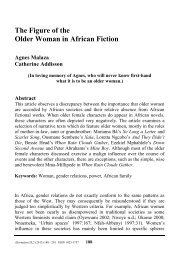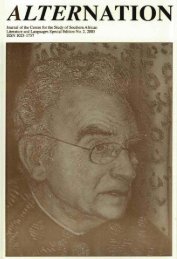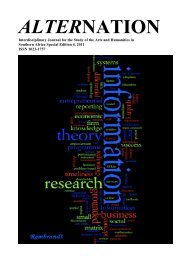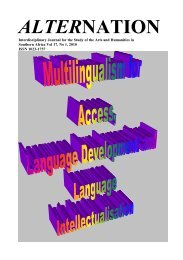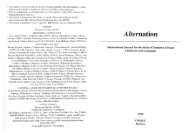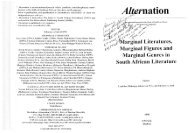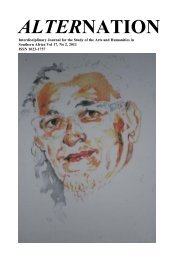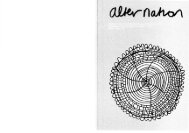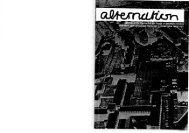Re-reading The Purloined Letter - Alternation Journal
Re-reading The Purloined Letter - Alternation Journal
Re-reading The Purloined Letter - Alternation Journal
Create successful ePaper yourself
Turn your PDF publications into a flip-book with our unique Google optimized e-Paper software.
Pravina Pillay<br />
Freudian and Lacanian psychoanalysis through a critique of logocentrism.<br />
Johnson (1980:119) asserts that as well as Derrida accusing Lacan of a<br />
general laxity in his deployment of philosophical sources, Derrida was<br />
concerned to identify and deconstruct the key metaphysical patterns mapped<br />
out by classic Oedipal triangulation. <strong>The</strong> model family structure which<br />
traces the child’s developing Oedipality is three-cornered, with the father<br />
intervening as the ‘third term’ to disrupt (in the child’s eyes) the relationship<br />
of the mother and the child. But, according to Williams (1995:75) the triad<br />
might be read in other ways too: through his subsequent anxiety, the child<br />
sees himself as the intervening factor between father and mother (hence the<br />
father’s role as threat), whilst it is the mother who represents the love-object<br />
for both father and child. In each pattern, a third person intervenes in the<br />
dyad of unity, introducing rivalry to the pattern. On one level this<br />
triangulation might seem to present a topographical critique of binary<br />
structures—the ‘either’, or the dynamic upon which the logocentrism which<br />
Derrida deconstructs rests. <strong>The</strong> Oedipal structure is an interrelationship with<br />
three corners (or moments) not two. How then do we understand Derrida’s<br />
charge made in his essay <strong>The</strong> Purveyor of Truth that Lacan is operating with<br />
an implicit Hegelian brief, that psychoanalysis itself is founded upon a<br />
family structure which is itself at root logocentric? R.A. Champagne<br />
(1995:84) states that for Derrida the third term of the Oedipal triangle does<br />
not act to deconstruct the relationship between the other two positions<br />
(which would mean that the father’s intervention unravelled the network of<br />
family relationships in which he is implicated). Rather, the Freudian and the<br />
Lacanian third term is incorporated in an Hegelian moment of synthesis, or<br />
Aufhebung. Of this Johnson (1980:122) writes:<br />
<strong>The</strong> problem with psychoanalytic triangularity, in Derrida’s eyes, is<br />
not that it contains the wrong number of terms, but that it<br />
presupposes the possibility of a successful dialectical mediation and<br />
harmonious normalization, or Aufhebung, of desire.<br />
<strong>The</strong> third term—the intervention of the father, threatening the mother-child<br />
dyad—offers not a breaking open but a continuation and consolidation of the<br />
family structure. <strong>The</strong> father comes in a spirit of disruption (disrupting a<br />
taboo desire), but acts out a moment of mediation between the two terms,<br />
388



